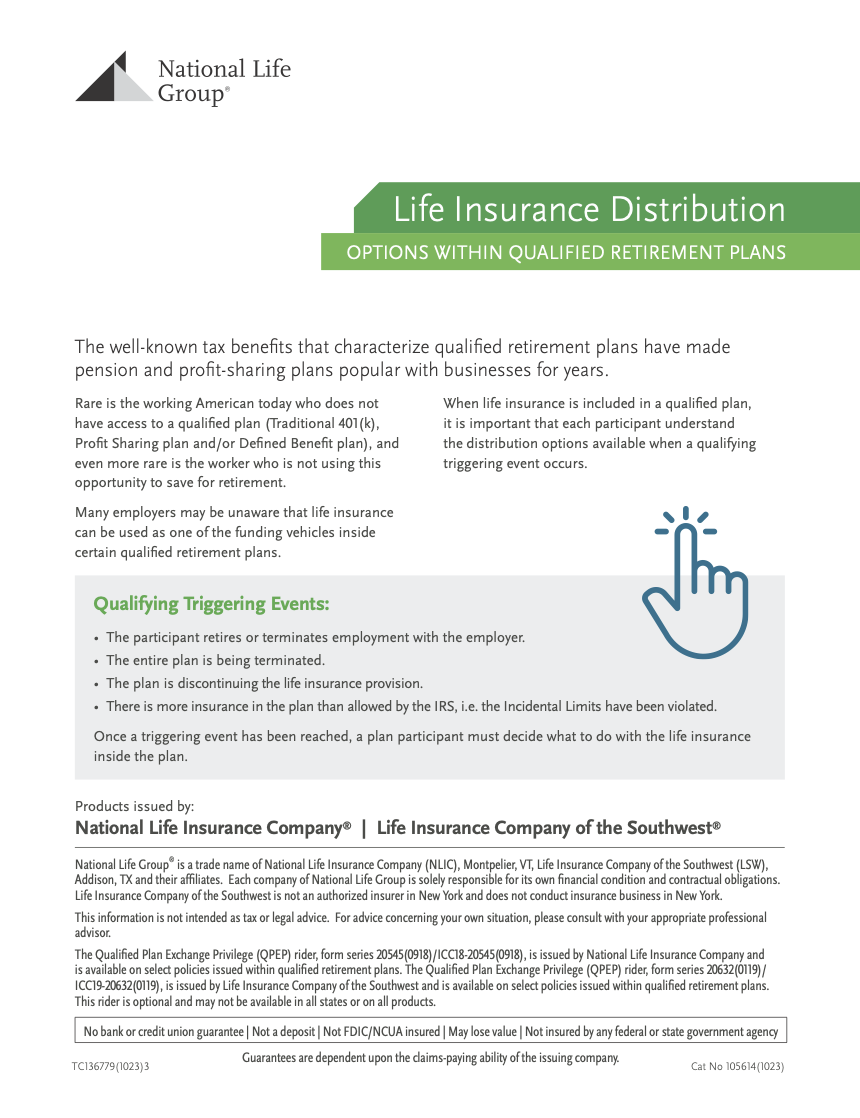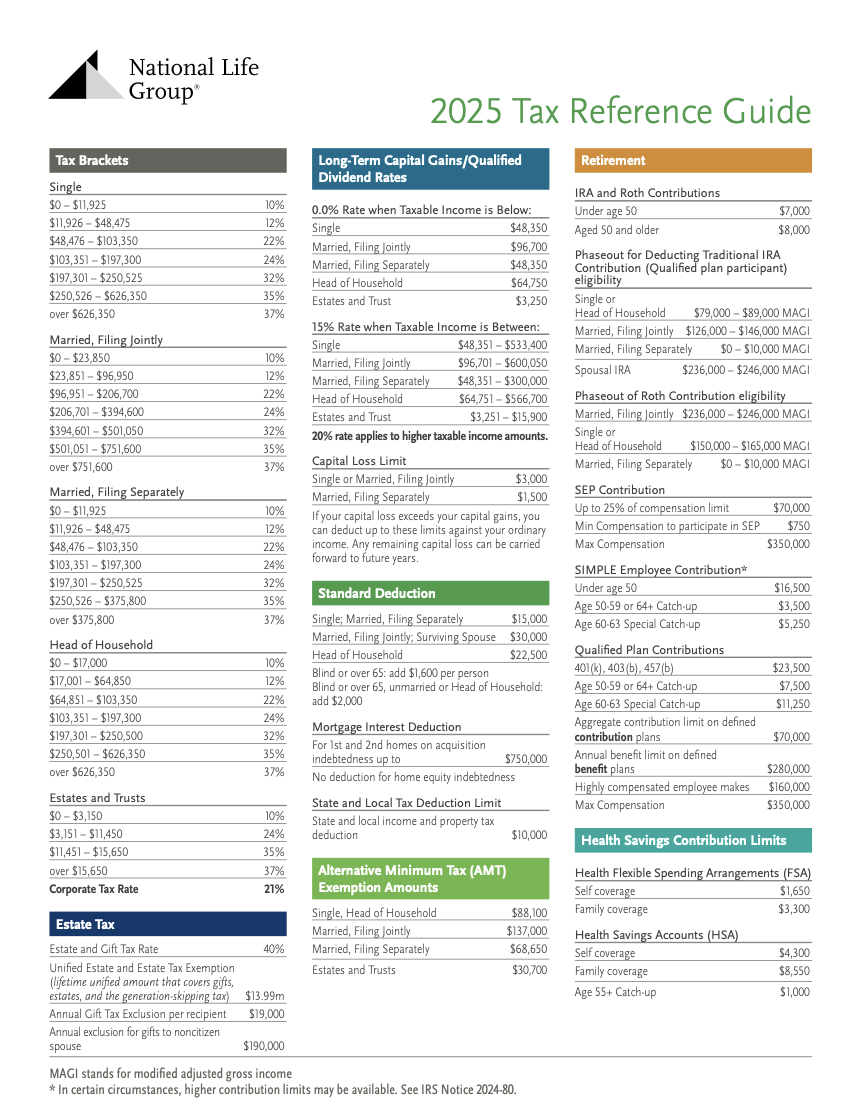Qualified Retirement Plans
HOW IT WORKS
When discussing qualified plans, there are two general categories: “Defined Contribution” and “Defined Benefit” plans.

DEFINED CONTRIBUTION
A Defined Contribution Plan is a tax-qualified retirement plan in which contributions are made by the employer into retirement accounts for participants. Participants can also be provided with the opportunity to make contributions through salary deferrals. The amount the employer contributes is specified by the plan and is generally based on employee compensation. A Defined Contribution Plan does not specify the benefit in retirement that will be available to the participant, only guidelines around the size of the contribution.

DEFINED BENEFIT
A Defined Benefit Plan is also a tax-qualified retirement plan, but contributions are made entirely by the employer with no option for employee deferrals. In a defined benefit plan, the plan specifies an amount that each participant will receive at retirement and contributions made into the plan must be sufficient to achieve that benefit as promised.
Defined Contribution
Different variations of defined contribution plans exist as well. A variety of investment vehicles can be included in these plans including stocks, bonds, annuities, mutual funds and life insurance.
Profit-Sharing Plans
In these types of plans, business owners can make discretionary contributions to employees thus allowing them to share in the company’s success. While the contribution could be based on company profits it is not a requirement. There are different types of profit-sharing plans to choose from.
Traditional Profit-Sharing Plan
The most basic form of profit-sharing plans, the employer’s annual contributions are divided equally among participants. There is no disparity between the percentage of salary allocated to the owner and that allocated to each eligible employee. The primary advantage to this plan is flexible contributions, as the business owner can determine the plan contribution each year.
Integrated Profit-Sharing Plans
This type of plan allows more of the employer’s contribution to be directed to those whose earnings exceed the Social Security Taxable Wage Base. Social Security benefits generally replace a larger percentage of lower-paid employees’ compensation. Therefore, Social Security integration can effectively give higher-compensated employees total benefits that are a similar percentage of salary compared with the benefits received by lower-compensated employees. Integration is a non-discriminatory way to get more contributions to highly compensated plan participants that does not jeopardize the plan’s tax-qualified status. The primary advantage of this plan is more of the contribution may be directed to the business owner and other employees with salaries that are greater than the rank-and-file employees.
Age Weighted Profit-Sharing Plans
This type of plan provides for employers to allocate more of the contribution to older employees who are closer to retirement age, and less to younger employees who have more time to save for retirement. The primary advantage of this plan is it is useful for attracting and retaining older, more experienced employees.
Cross-Tested Profit-Sharing (Profit-Sharing Select) Plans
This plan gives the employer the flexibility to define groups of employees and allocate contributions differently to each group. The primary advantage of this plan is that the employer has more freedom to decide who will benefit and how much they will receive. The IRS requires a minimum contribution, the lesser of 5% of the participant’s salary or 1/3rd of the percentage allocated to the owner, be given to rank-and-file employees.
Each plan is unique and contributions to non-highly compensated employees will depend on the age and salary of the owners and key/highly compensated plan participants. If owners and key/highly compensated plan participants are older and/or make a higher salary than non-highly compensated employees, it may be possible for owners to benefit specific employees, while keeping contributions low.
401(k) Plans*
These are different than profit-sharing plans as they allow highly and non-highly compensated employees to make deferrals on a pre-tax basis, after-tax basis, or a combination of both. The 401(k) plan may include an employer match, employer non-elective contribution and/or discretionary profit-sharing contributions.
Traditional 401(k) Plan
With this type of a plan, a business owner can provide a match in addition to employee deferrals but is under no obligation to do so. Participating employees will be classified as highly compensated or non-highly compensated based on criteria established by the IRS. The amount of salary deferral allowed for highly compensated employees cannot exceed more than 2% of salary over the average deferral of rank-and-file employees. A test called the Actual Deferral Percentage (ADP) Test is performed by the third-party administrator each year to ensure that the highly compensated employees do not defer over the limits allowed.
Safe Harbor 401(k)
These plans are not required to follow the ADP test and allow highly compensated plan participants to defer the individual maximum amount allowed, regardless of what non-highly compensated employees defer as long as one of the two following “Safe Harbor” options are offered.
1. A dollar-for-dollar match of up to the first 3% of salary that an employee defers and $.50 on the dollar on the next 2% of salary that an employee defers must be offered each year. The match goes only to those employees who defer.
or
2. A non-elective contribution of 3% of salary must be given to all employees who are eligible to defer in the 401(k) plan, even if they elect not to defer.
Whether the match or non-elective contribution is selected, it is 100% immediately vested to the participants.
Solo 401(k) Plan
This type of plan is available for a business that has only highly compensated employees eligible to participate in the plan. As a result of the limited participants, the ADP test does not have to be followed and no “Safe Harbor” option needs to be offered.
*Advisors must possess an active securities license in order assist clients with 401(k) plans. for questions regarding the proper licensing please consult with your broker dealer.
**The producer must possess an active securities license if stocks, bonds and/or mutual funds are to be offered as investment options in the plan.
Defined Benefit
There are different variations of defined benefit plans for business owners to choose from. In each type of defined benefit plan, the employer makes tax-deductible contributions on an annual basis for all eligible plan participants.
Traditional Defined Benefit Plans
In this type of plan, contributions are calculated annually by an Enrolled Actuary who will also complete an annual certification of the funding level. The contribution amount is based on assumptions surrounding expected rates of return, employee demographics, salary increases, and other factors including the underlying products chosen. The trustee (often the employer) of the plan will select the investments, which can include life insurance.
Fully Insured § 412(e)(3) Defined Benefit Plans
For plans pursuant to Internal Revenue Code (“Code”) section 412(e)(3), each participant is provided with a predetermined, guaranteed benefit amount. This benefit is fully insured (and calculated) based on the funding of the plan, which is limited to an annuity or a combination of whole life insurance and an annuity. Because plan benefits are guaranteed, any “excess” interest earnings (or dividends, if paid) over and above the life or annuity contract guarantees are used to reduce the next year’s premium. Unlike a traditional defined benefit plan, no Enrolled Actuary Certification is needed since the plan is funded entirely from the guaranteed element of the underlying insurance contracts.
Cash Balance Plans
A cash balance plan is a hybrid pension plan which blends attributes of a traditional defined benefit plan with a defined contribution plan. Similar to a defined contribution plan, a cash balance plan defines a contribution, which is a percentage of salary, but contribution maximums fall under defined benefit rules.
Combining Plans
Combining Plans
Some businesses may have the desire and capability to fund a qualified plan beyond the limits imposed for each one (see the section on tax treatment). It is important to remember that a business owner is not limited to one qualified plan. Combining different types of plans will create a more enticing benefits package for employees and provide for larger, tax-deductible contributions.
For instance, a Profit-Sharing Plan can be combined with a 401(k) plan to provide employer contributions in addition to elective deferrals made by participants. Or a 401(k) profit-sharing plan can be combined with a defined benefit plan for an even greater deduction. However, if the business is a professional services firm, and a defined benefit plan and profit-sharing plan are funded in the same fiscal year, the maximum employer contribution into the profit-sharing plan will be limited to 6% of eligible compensation.
THE ROLE OF THE TPA
What is a TPA?
A Third-Party Administrator (TPA) is an organization that handles the administration of a retirement plan. The administrative responsibilities inherent in a qualified plan are quite expansive and failure to comply can result in significant financial penalties for the sponsoring business. Having a TPA involved in overseeing a qualified plan can provide business owner(s) with peace of mind and allows them to focus more on regular business operations.
What does a TPA do?
The tasks performed by TPAs include:
- Putting together the Plan Document
- Coordinating the issuance of the individual policies
- Preparing benefit statements for both the employer and plan participants
- Handling Transactional Requests from Plan Participants
- Ensuring that the plan remains compliant with IRS requirements
- Preparing reports required by the IRS, DOL and other government agencies
- And so much more
Do you need a TPA?
Yes. National Life Group requires the use of a TPA for all Qualified Plans.* Though National Life Group cannot serve in the role of TPA, our Advanced Markets team can provide a list of providers that can serve in this role.
*Exceptions include SEP and SIMPLE IRA plans as well as Solo 401k plans that have less than $250,000 in assets.
Want to learn a few tips for success when working with the TPA? Click the video below to hear how one experienced agent interacts with the TPAs he works with.
TECHNICAL AND TAX CONSIDERATIONS
Required Provisions in Qualified Plans
General Eligibility
All full-time employees who are age 21 and older and have completed one year of service must be eligible to participate in a qualified plan. A two-year service requirement may be used if the plan provides for 100% immediate vesting after two years. Part-time or seasonal employees, if employed less than 1,000 hours annually, may be excluded depending on the terms of the plan.
However, as of January 1, 2021, § 401(k) plans must allow long-term part-time employees to participate in the plan as it relates to the opportunity to make elective deferral contributions. This rule applies to part-time employees who have worked at least 500 hours in the preceding three consecutive 12-month periods starting January 1, 2021. Therefore, such employees will not be eligible to participate until their first three 12-month periods end (some time in 2024).
Nonresident aliens with no source of U.S. income and employees covered by a collective bargaining agreement may also be excluded. It might be possible to exclude some additional employees as long as the plan follows very specific coverage testing guidelines established by the IRS.
Vesting Requirements
Participants in defined contribution and defined benefit plans must eventually have a non-forfeitable right to their benefits based on a predetermined vesting schedule selected by the plan trustee.
Defined Contribution Plans
Employee contributions, such as salary deferrals into a 401(k) plan and Safe Harbor matching or non-elective contributions must be fully and immediately 100% vested.
Employer contributions can be fully and immediately 100% vested or they can be subject to a vesting schedule that is no less generous than either of the following:
- Three Year Cliff Vesting – Participants are 100% vested after three years of service
- Two-to-Six Year Graded Vesting – Participants must be at least 20% vested after two years of service, resulting in 100% vesting after six years of service.
If a plan is top-heavy, either 100% immediate vesting, three-year cliff vesting, or six-year graded vesting is required.
Defined Benefit Plans
Vesting schedules must be no less generous than:
- Five-Year Cliff – Participants are 100% vested after five years of service.
- Three-to-Seven Year Graded – Participants must be at least 20% vested after three years of service and acquire another 20% for each additional year of service, resulting in 100% vesting after seven years of service.
If the plan is top-heavy, employer contributions can be fully vested immediately or one of the following vesting schedules is required:
- Three Year Cliff – Participants are vested after three years of service, or
- Two-to-Six Year Graded Vesting – Participants must be at least 20% vested after two years of service and acquire another 20% for each additional year of service, resulting in 100% vesting after six years of service.
Forfeitures
- Forfeitures result when employees who are not fully vested in the plan terminate employment.
- In a defined contribution plan, any non-vested forfeiture amounts must be reallocated to the accounts of remaining participants or used to reduce employer contributions to the plan.
- In a defined benefit plan, if an employee is not 100% vested, any non-vested forfeiture amounts must be used in the plan to reduce the employer’s plan contribution in the next year.
Distributions from Qualified Plans
Distributions from defined contribution and defined benefit plans may be made in the event of retirement, permanent disability, termination of employment, or death. Distributions may be paid to participants or their beneficiaries in the form of monthly installments or in a lump-sum, if permitted by the plan.
Required Minimum Distributions (RMDs) are the minimum amount that a retirement plan account owner must withdraw annually starting with the year that he or she reaches 72 or if later, the year in which he or she retires. However, if the retirement plan account is an IRA or the account owner is a 5% owner of the business sponsoring the retirement plan, the RMDs must begin once the account holder is age 72, regardless of whether he or she is retired.
Retirement plan participants and IRA owners (including owners of SEP IRAs and SIMPLE IRAs), are responsible for taking the correct amount of RMDs on time every year from their accounts, and face a penalty for failure to take RMDs.
Special Rules for Defined Benefit Plans
- At retirement, benefit payments are paid to participants, as guaranteed under the plan.
- In addition to retirement benefits, the plan provides a survivor death benefit (as required by the IRS), and may provide larger insured death benefits, early retirement benefits, and/or disability benefits.
- If a participant dies prior to retirement, an insured pension plan pays a death benefit in the form of an income stream or lump sum payment to the participants named beneficiary.
Loans
Defined contribution and traditional defined benefit plans may allow loans to participants prior to retirement or termination of service (note that 412(e)(3) plans do not allow loans). Outstanding loans may not exceed the maximum of $50,000 or 50% of the participant’s vested accrued account balance. The $50,000 limit is reduced by the excess of the highest outstanding loan balance within one year of a new loan. The loan must be repaid in equal installments, at least on a quarterly basis, within five years, unless the loan is secured for the purchase of the participant’s principal residence. Loan interest is not deductible.
Life Insurance in a Qualified Plan
Alongside other more traditional plan assets (stocks, bonds, mutual funds, etc.), qualified plans may also purchase life insurance on the lives of the participants to provide participants a pre-retirement death benefit. However, life insurance can be included in a qualified plan only if it is incidental to the primary purpose of the plan, which is providing retirement benefits. This is referred to as the Incidental Benefit Rule, with which both defined contribution and defined benefit plans must comply.
Why add life insurance to a qualified plan? The below video discusses some of the key benefits:
Defined Contribution Plans
There are two ways to calculate the amount of the contribution that can be allocated to a life insurance premium.
- If (indexed) universal life insurance is in the plan, each participant can allocate up to 25% of their annual contribution for the life insurance premium.
- If whole life insurance is in the plan, each participant can allocate up to 49.9% of their annual contribution for the life insurance premium.
Profit-sharing plans also have “seasoned money” rules pertaining to life insurance. These rules potentially allow for even more of the contributions in the plan to be used to pay the life insurance premium for a participant’s account. The seasoned money rules include a two-year rule and a five-year rule. Under the two-year rule, 100% of the money in a participant’s account (including earnings) that has been in the account for least 2 years may be reallocated towards a life insurance premium under the profit-sharing plan. The five-year rule allows anyone with at least 60 months of participation in a profit-sharing plan to direct up to 100% of their account (both old and new money) towards life insurance.
Defined Benefit Plans
There are two ways to calculate the amount of the contribution allocated to life insurance premium.
- The “100-Times Test” calculates a pre-retirement death benefit that does not exceed 100 times the participant’s monthly retirement benefit or the present value of the accrued benefit, whichever is greater. The insurance death benefit formula is expressed as a multiple of the monthly retirement benefit.
- The “Two-Thirds Rule” (Rev. Ruling 74-307) uses an actuarial formula to calculate the amount of the contribution going to the life insurance premium. This method will generally produce larger face amounts of insurance than the 100-Times Test.
Distribution Planning Considerations
When a participant who is entitled to a distribution from a qualified plan wishes to continue the life insurance provided through the plan after termination of employment, there are typically limited options for accomplishing this. These options include:
1. Purchasing the Life Insurance Policy from the Plan
- The policy must be purchased for its Fair Market Value
- The plan administer will want to document that the sale of the policy to the insured/participant meets the requirements of the Department of Labor’s Prohibited Transaction Exemption 92-6.
Or
2. Distribute the Policy to the Participant/Insured
- The participant/Insured must include the policy’s fair market value in income
- The participant may offset the amount included in income by the cumulative amount of the cost of insurance included in income over the years.
But at National Life, we offer a unique third option…
Our permanent products come with a unique benefit called the Qualified Plan Exchange Privilege (QPEP) Rider.
This rider allows for a life insurance policy within a qualified plan to be exchanged for a new, permanent policy outside of the plan without new underwriting and with no immediate tax consequences.
Upon activation of this rider, a new policy is issued for the participant outside of the qualified plan, at their current age and same rate class, for the net amount at risk of the policy in the plan (face amount – cash value). The original policy’s cash value can be distributed to the participant or rolled into a tax deferred account such as an IRA.
Tax Considerations
When life insurance is provided in a qualified plan, the participant/insured is receiving a current benefit by way of the life insurance protection. This is referred to as an “economic benefit.” As a current economic benefit, the participant/insured must include in income each year the cost of the death benefit coverage. The economic benefit is determined by using the lower of IRS Table 2001 (previously known as the “PS 58” table) or the carrier’s generally available term rates applicable to all insureds.
Should the insured die before retirement with the life insurance held in the plan, the beneficiary would receive the net amount at risk portion of net death benefit as an income-tax free death benefit.

CASE STUDY
John and Susan

John (55) and Susan (50) are both 50% owners of a very successful dental practice. They have two hygienists and one office manager on staff as well. John and Susan’s focus throughout most of their careers has been on building their business and they are now realizing their shortfalls in saving for retirement. Furthermore, the success of their business has led to higher tax liability and they are in search of opportunities to create a greater savings in this area as well. In addition, employee turnover is a costly ordeal for them, and they would like to find a way to entice current staff to stay with the business.
The ages and average salaries for all members of the business are as follows.
Name
Age
Average Salary
John
55
$300,000
Susan
50
$300,000
Hygienist 1
37
$60,000
Hygienist 2
33
$55,000
Office Manager
50
$45,000
Case Study Results
Option 1: Safe Harbor 401(k)
Assume that it is John and Susan’s preference to maximize their savings potential through a flexible plan that provides for both employer contributions and employee salary deferrals. A safe harbor 401k plan with a non-elective contribution in combination with a cross-tested profit sharing plan could be an effective strategy. This model will allow for John and Susan to maximize contributions for their respective benefits/while staying in compliance with non discrimination guidelines.
Safe Harbor 401(k) with 3% Non-Elective Match and Cross Tested Profit-Sharing Plan*
Elective Deferral
Non Elective
Profit Sharing
Plan Total
John
$27,000
$9,000
$31,500
$67,500
Susan
$27,000
$9,000
$31,500
$67,500
Hygienist 1
$1,800
$1,800
$1,200
$4,800
Hygienist 2
$1,650
$1,650
$1,100
$4,400
Office Manager
$1,350
$1,350
$900
$3,600
- Percentage of contribution to Owners – 91%
- Total Cost of Plan – $147,800
- Total Tax Savings (assuming 37% rate) – $54,686
- Net After Tax Cost of the Plan – $93,114
*Assumes that the plan consists of two subgroups. Group 0-Owners will consist of John and Susan and they will receive an allocation equivalent to 10.5% of pay. Group-Non-Owners will consist of the two hygienists and the office manager and they will receive an allocation equivalent to 2% of pay.
Assumes that John and Susan contribute the maximum salary deferral limit of $20,500 plus a $6,500 catch up for individuals 50 and over and that all others defer 3% of salary. Please refer to the IRS website for current contribution limits. Retirement Topics – Contributions | Internal Revenue Service (irs.gov)
If John and Susan are looking to contribute more than what the profit-sharing plan allows, implementing a fully insured 412(e)(3) plan would help to create the largest possible tax deductible contribution for John and Susan’s business.
Fully Insured 412e(3) Defined Benefit Plan*
Annuity
Life
Premium
Total
Contribution
Face Amount
Monthly Retirement Benefit
John
169,635
173,035
342,670
5,739,394
6,000
Susan
137,619
161,794
299,413
6,947,758
10,548
Hygienist 1
11,501
18,207
29,708
1,417,396
2,768
Hygienist 2
8,060
14,012
22,072
1,286,813
2,537
Office Manager
21,562
25,309
46,871
1,085,000
1,650
- Percentage to Owners – 87%
- Total Cost of Plan – $740734
- Total Tax Savings (assuming 37% rate) – $274072
- Net After Tax Cost – $466,662
*This plan assumes a combination of the Totalsecure Whole Life (standard non-tobacco rating) as well as the Fit Secure Growth annuity is used for all participants with funding done for the greater of five years or attainment of age 62. It is also assumed for the purposes of this design that the salaries in figure 1 represent an average of the three highest consecutive years of compensation.
National Life Group® is a trade name of National Life Insurance Company, Montpelier, VT, Life Insurance Company of the Southwest, Addison, TX and their affiliates. Each company of National Life Group is solely responsible for its own financial condition and contractual obligations. Life Insurance Company of the Southwest is not an authorized insurer in New York and does not conduct insurance business in New York.
The companies of National Life Group® and their representatives do not offer tax or legal advice. Please encourage your clients to seek tax or legal advice from their appropriate professional advisor.
FOR AGENT USE ONLY – NOT FOR USE WITH THE PUBLIC
TC7869376(0425)3 | Cat 106313(0425)






